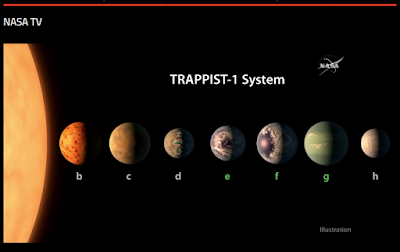TRAPPIST-1
Why revealed*? Because the researchers of The Transiting Planets and Planetesimals Small Telescope (TRAPPIST) in Chile, in May, 2016, announced they had discovered 3 planets in a system. Then several ground based telescopes assisted this discovery (That 2 planets have sure existence) and at last Spitzer Space Telescope of NASA after a observation of 500 h confirmed the existence of the 2 planets & 5 additional ones.
Now let's learn a little more.
The system is 40 light years far from Earth. This is a one star system. The star is classified as ultra-cool dwarf (So cool that liquid water can be there on the planets orbiting very close to it). The planets in TRAPPIST-1 system is orbiting this star at a distance closer than Mercury to Sun. And the stars are orbiting too close to each other as well, such close that if we are in one of those we can see the others from the ground (bigger than the Moon), can see other planet's clouds, even geological features (So cool!). The planets may be tidally locked to the star as well, means the same side of the planet is facing the star, i.e. in one side perpetual day and in other perpetual night. This can make some odd weather conditions there like strong wind blow from one side to another, extreme temperature change etc. The diameter & weight of 6 planets of this system is already precisely measured and of the remaining one will be disclosed soon. 3 of the 7 plants are in habitable-zone. Though water cen be there in all of them, in those 3, the probability is the most. Every planet is rocky except the last one which could be a ice-ball.
A estimated ground view from TRAPPIST-1f
So the discovery is great as said, "This is the most exciting result I have seen in the 14 years of Spitzer operations", by Sean Carey, manager of NASA's Spitzer Science Centre at Caltech/IPAC in Pasadena, Califirnia.
More information is to be disclosed, don't worry, research going. Wait and have your eyes on NASA.





Comments
Post a Comment